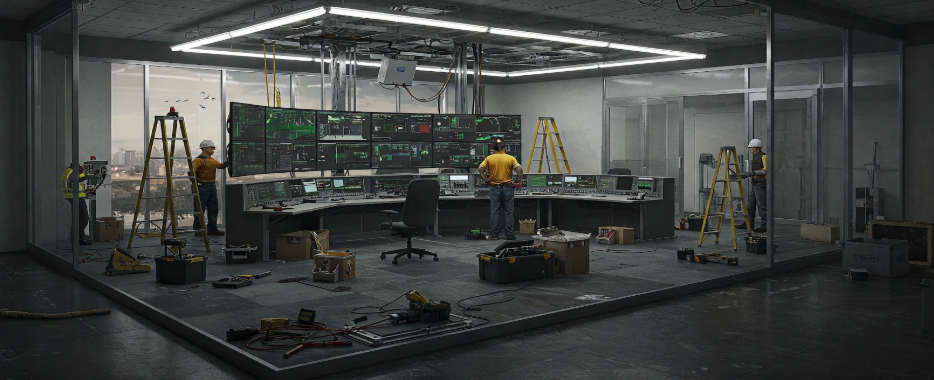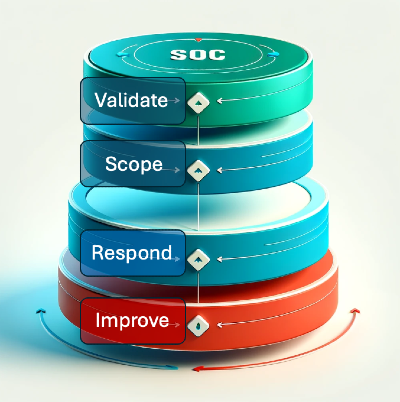Rethinking the SOC Three-Tier Model

In cybersecurity, operational models are more than academic—they define how teams respond to threats, allocate resources, and maintain continuity. At the heart of Security Operations Centers (SOCs) lies the Three-Tier Model, a framework meant to organize how alerts are handled from detection to resolution. Not all models are created equal.

The model we’ve seen succeed in real-world SOC environments—especially those focused on outcomes over alert volume—follows this structure:
- Tier 1: Validation – Monitoring and confirming whether incoming alerts are valid and actionable.
- Tier 2: Scope – Investigating validated alerts to determine what systems, users, and behaviors are involved.
- Tier 3: Response – Taking action based on the scope: containment, mitigation, and recovery.
This model reflects the natural workflow of security operations: first, confirm the signal; second, understand the threat; third, act on it. Each tier has a clear purpose and distinct handoff, ensuring decisions are informed and responsibilities are not blurred.
In contrast, the more commonly cited SOC model—Tier 1: Triage, Tier 2: Investigation & Response, and Tier 3: Threat Hunting & Forensics—prioritizes the flow of alerts rather than the outcomes of operations. It blurs the line between investigation and response, and inappropriately elevates threat hunting and forensics (which are essential but supportive functions) into core operational tiers. This older model assumes a linear escalation, when real-world SOCs depend on parallel specialization and coordinated action. In practice, response teams cannot act until scope has been clearly defined—merging these roles causes delays, inefficiencies, and confusion.
By anchoring our model in the realities of how incidents unfold, we create a more efficient, focused, and resilient SOC.
The Three Tiers That Drive Action
Tier 1: Validation
Tier 1 in a Security Operations Center (SOC) serves as the entry point for operational decision-making, not just an alert triage desk. Its primary role is validation, determining whether incoming alerts represent real, actionable security concerns. Analysts in this tier are not simply forwarding alerts—they are the first line of informed defense. They assess system-generated alerts from various sources such as EDR platforms, firewalls, and identity systems, ensuring each is both valid and relevant. This involves interpreting structured alerts, contextualizing them with known behaviors, and verifying whether further action is warranted.
The job of a Tier 1 analyst is nuanced and analytical. They must understand how systems behave under normal conditions and how those behaviors manifest in log data. Their decisions are grounded in context: Is a failed login part of a brute-force attempt or a simple mistyped password? Is an alert firing due to known testing activity, or does it indicate suspicious lateral movement? These decisions are recorded with clear justifications—not only to support escalation but also to provide feedback that can refine alerting logic over time.
In practice, this means the Tier 1 analyst must be fluent in reading logs, understanding detection logic, and applying critical judgment. When alerts are deemed invalid or benign, they are closed with rationale. If they appear legitimate but require further review, they are escalated to Tier 2 for deeper investigation. Importantly, this escalation must be justified and complete—alerts should be accompanied by any enrichment (e.g., observed behaviors, user or asset details) that assists in downstream analysis. The clarity and precision of Tier 1 output directly affects the speed and success of the investigation that follows.
Unlike traditional “triage” descriptions, the Validation tier is a true operational function, not a clerical one. Analysts at this level must balance speed with accuracy—acting quickly to suppress false positives without overlooking legitimate threats. They must also manage alert queues efficiently, prevent fatigue, and avoid escalation overflow. Their decisions reduce noise, establish investigative focus, and form the foundation for all actions that follow. A weak Tier 1 results in wasted time and missed threats; a strong Tier 1 ensures the SOC functions with clarity, direction, and purpose.
Ultimately, Tier 1 is about trust and signal clarity. The rest of the SOC relies on Tier 1 to make informed decisions that define what the team should focus on. Without this first layer of analysis, security operations devolve into guesswork or alert-chasing. With it, organizations gain a consistent, disciplined filter that ensures attention is placed where it matters most—on genuine threats to the business.
Tier 2: Scoping and Impact Analysis
Once an alert is validated by Tier 1, it transitions to Tier 2: Scoping, where the primary objective is to determine the breadth and depth of the event. This is not simply a continuation of analysis—it is a transition into investigative work that connects events into a larger narrative. The Tier 2 analyst is responsible for establishing what systems, users, and data are impacted, and whether the activity is isolated or part of a wider compromise. Alerts, in isolation, may hint at an issue, but it is Tier 2’s job to piece together the full story, transforming a singular detection into a fully scoped security issue.
Scoping involves a wide range of analytical tasks. Analysts must correlate multiple logs, artifacts, and behavioral indicators across time and systems. For example, a suspicious login might be just the start: Tier 2 investigates what happened before and after, asking if there was unusual access, privilege escalation, or new processes launched. Analysts must also search for objects of interest—file hashes, IPs, usernames, or domain names—and determine whether these artifacts appear elsewhere in the environment. This search often uncovers hidden links between endpoints and surfaces evidence of lateral movement or deeper compromise.
Tier 2 also plays a critical role in evaluating business and operational impact. Scoping is not purely technical; it considers questions like: Was sensitive data accessed? Was a privileged account involved? Could the attacker have reached critical infrastructure? This understanding allows Tier 3 to act decisively and proportionately. Without proper scoping, response teams may either overreact—taking systems offline unnecessarily—or underreact—missing key systems or allowing threats to persist. Thus, Tier 2 serves as the bridge between detection and action, providing clarity to support containment, mitigation, and recovery.
Effective Tier 2 work requires clear documentation and communication. Analysts must deliver a structured summary of findings, listing affected users, impacted systems, and known artifacts. They also note where indicators appear across the infrastructure and flag uncertainties for further review. These outputs drive the success of Tier 3. When scoping is thorough, Tier 3 can act with precision. When it is vague or incomplete, response becomes delayed, redundant, or misaligned with business priorities. In this way, Tier 2 is not just the middle tier—it is the analytical core of SOC operations, transforming noise into knowledge and guiding the organization toward resolution.
Tier 3: Response & Recovery
Tier 3 is where decisions are transformed into action. Once an incident has been validated (Tier 1) and scoped (Tier 2), the responsibility for containment, mitigation, and restoration falls to the Tier 3 analyst. This role is not merely about fixing technical issues—it is about preserving and restoring business operations while ensuring the threat is neutralized. Tier 3 analysts coordinate closely with IT and business units to stabilize operations and minimize downtime. In doing so, they serve as the bridge between cybersecurity and enterprise resilience, ensuring that technical responses align with business continuity needs.
Once operational stability is ensured, containment becomes the immediate focus. This includes isolating infected systems, suspending compromised accounts, deploying firewall changes, and halting malicious activity. What makes Tier 3 unique is its real-time execution role—unlike Tier 2, which is focused on analysis and scoping, Tier 3 is charged with taking action. Their success hinges on having a precise understanding of the scope provided by Tier 2. However, their expertise lies in knowing how to implement those changes effectively, often under pressure and within live production environments.
Mitigation goes beyond immediate containment—it is the process of cleansing the environment and removing any attacker footholds. This could involve removing malware, resetting credentials, patching vulnerabilities, or reverting compromised systems to known-good states. Recovery follows closely, involving activities such as system restoration, data recovery, and validation of restored services. Tier 3 analysts typically have a strong systems administration background, with in-depth knowledge of Windows, Linux, cloud platforms, and identity systems. They understand the downstream effects of changes made in live environments and know how to apply fixes with minimal disruption.
Critically, Tier 3’s role is not only tactical but also strategic. While Tier 2 focuses on understanding what happened, Tier 3 is focused on improving the organization’s security posture moving forward. Each incident provides insight into where defenses were weak—whether it was a misconfiguration, a lack of detection coverage, or a gap in process. Tier 3 analysts often lead the effort to implement compensating controls, update playbooks, improve endpoint baselines, or work with engineering teams to harden infrastructure. They don’t just close incidents—they transform them into opportunities to increase resilience.
Why Threat Hunting and Forensics Are Not Tiers
While commonly referenced in discussions about SOC structure, Threat Hunting and Forensics are not operational tiers—and they shouldn’t be treated as such. Both functions are essential to the overall security posture of an organization, but they operate outside the real-time response cycle. Tiered SOC models should reflect roles that exist on the critical path of alert validation, scoping, and response. Threat hunting and forensic analysis, while vital, are parallel disciplines that support the SOC from the side—not components embedded within the operational timeline.
Threat hunting is often framed as a proactive approach to detection: analysts manually combing through logs and telemetry in search of undetected threats. However, this is a reactive measure by nature, invoked when existing detection logic has failed to surface an issue. In that sense, threat hunting is not a primary line of defense—it is a diagnostic and exploratory process used to uncover weaknesses. The real value of threat hunting lies not in the hunt itself, but in what comes afterward. The findings—whether behavioral anomalies, overlooked attack chains, or subtle lateral movement—should be fed back into Tier 1. Hunting outputs drive the creation of new detection rules, enrich alert logic, and inform better threat modeling. If threat hunting remains isolated, it becomes anecdotal. If integrated, it becomes transformative.
Forensics, likewise, plays an important but non-operational role. With the advent of EDR and continuous telemetry collection, many of the time-sensitive questions once answered by forensic analysis are now handled directly within the SOC’s Tier 2 scoping process. Today, forensics is most useful after the fact: in breach investigations, legal proceedings, and detailed retrospectives. It is deliberate and thorough, but not suited for real-time analysis. The forensic process lacks the speed and immediacy required to make operational decisions in the moment. Instead, it excels at root cause analysis and evidence preservation, both of which are critical for organizational learning and legal preparedness—but not part of day-to-day incident flow.
The true contribution of both threat hunting and forensics is in their ability to strengthen the SOC over time. Their insights lead to better detection and behavioral rules, more comprehensive playbooks, and improved standard operating procedures (SOPs). They are forces of refinement, helping the SOC evolve, reduce blind spots, and adapt to emerging tactics. In mature environments, these functions are essential—but only when their outputs are systematized and returned to the operational pipeline. They should never remain isolated technical silos or be mischaracterized as reactive components of the incident response process.
By clearly delineating operational tiers (Validation, Scoping, Response) from supporting and strategic functions, SOCs maintain a focused, efficient, and effective structure. Threat hunting and forensics elevate the organization’s maturity, but they do so by informing and enhancing the operational tiers—not by becoming one.
Why This Model Matters
The traditional model—Triage, Investigation & Response, Threat Hunting—may appear straightforward, but it fails to align with how modern Security Operations Centers actually function. By blending analysis, response, and strategic activities into overlapping roles, it creates blurred boundaries, inconsistent workflows, and operational delays. It assumes the same individuals can validate alerts, investigate incidents, and execute response—all while also proactively hunting for new threats. In practice, this leads to confusion, role fatigue, and delayed action. Effective response requires that each tier understands what it owns, what it produces, and when it should act—something the traditional model fails to clearly define.
Our revised model—Validation, Scoping, and Response & Recovery—reflects the actual flow of operational security work. Each tier is designed not just around technical expertise, but around output and decision-making responsibility. Tier 1 determines whether an alert is real and worth attention. Tier 2 determines what systems, users, and data are involved. Tier 3 decides what actions must be taken to contain and recover. This separation ensures that alerts are meaningful, investigations are thorough, and responses are accurate and timely. Most importantly, it supports parallel specialization, where multiple analysts or teams can collaborate without stepping on each other’s workflows.
This model also puts threat hunting and forensics in their proper place—not as operational tiers, but as supporting capabilities. Their greatest value comes not from being on the front line, but from improving detection logic, refining procedures, and strengthening post-incident understanding. By removing these functions from the critical path, the model emphasizes their strategic role in enhancing SOC maturity without disrupting day-to-day operations.
Ultimately, this modern tiered model delivers what a SOC needs most: clarity, accountability, and operational effectiveness. It reduces noise, improves response precision, and fosters a culture of structured, repeatable security. Rather than reacting to alerts in isolation, teams act with purpose—guided by clearly defined stages and outputs. For organizations looking to build or refine their SOC, adopting this model means moving beyond traditional escalation flow and embracing a process-driven, outcome-focused approach to security operations.




